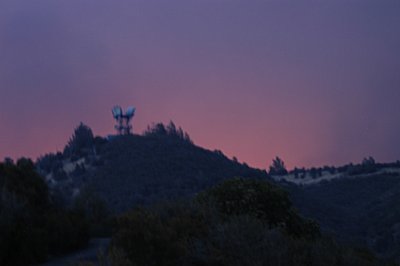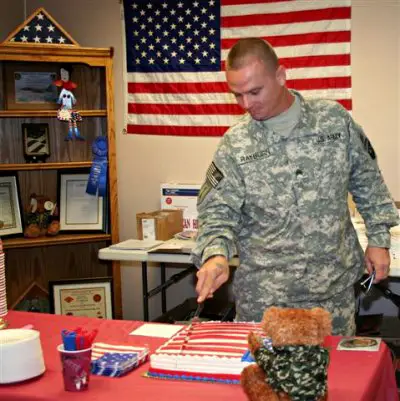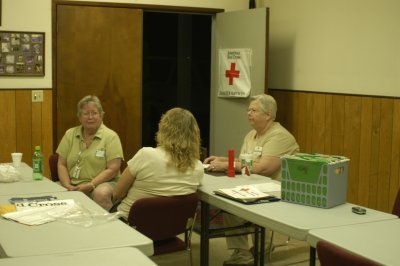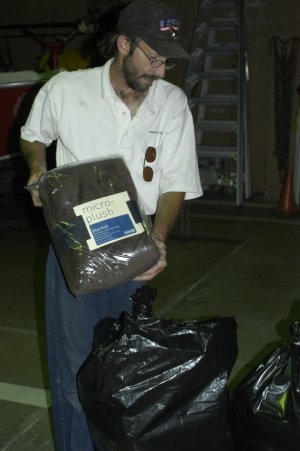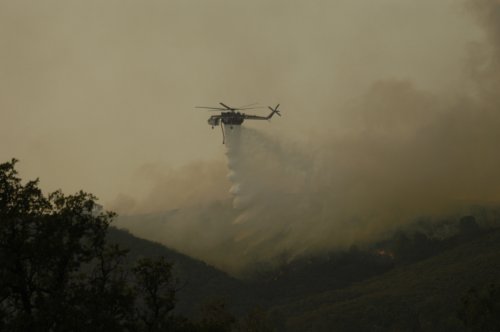
A Sikorsky Skycrane helicopter drops 750 gallons of water on a portion of the Walker Fire at about 6 p.m. Monday evening. Photo by Elizabeth Larson.
WALKER RIDGE – A wildland fire burning in a remote part of the county nearly tripled in size Monday, with winds causing the blaze to jump fire lines as it continued on its path toward dozens of homes.
The Walker Fire had burned 10,000 acres with zero containment by 7 p.m. Monday, according to Frank Kemper, a Cal Fire spokesman at the incident command center at the Oasis road house along Highway 20.
The fire was continuing to burn over the ridge toward the Double Eagle Ranch subdivision, which is located about 14 miles east of Clearlake Oaks.
Northshore Fire Chief Jim Robbins said the fire was heading for the Lake/Colusa County line and the Bear Valley area, where area ranches might need to be evacuated.
Sixty-two personnel and 13 engines from all county fire districts and Cal Fire were on scene Monday, fighting what has become one of the largest uncontained wildland fire burning in the state, according to Cal Fire statistics.
Thirty-five structures were reported threatened, with one older hunting cabin in Benmore Canyon destroyed, said Robbins.
There also is the very real possibility that, if winds shift and the fire change directions, it could head toward Spring Valley, necessitating evacuations, Robbins said.
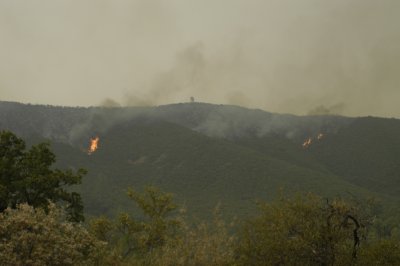
The fire burns in an area about one ridge away from the main part of the Double Eagle Ranch subdivision Monday evening. Photo by Elizabeth Larson.
Jeffrey Tunnell, a fire mitigation and education specialist with the Bureau of Land Management, said the fire was burning a mix of private property and BLM-managed wildlands.
A BLM ranger spotted the fire in the remote Benmore Canyon area on Sunday, said Tunnell.
No injuries have been reported, said Robbins. “That's our main objective – to keep everyone as safe as possible.”
Robbins said Cal Fire took over as the lead agency on the fire Sunday.
Needing more help
Local fire officials were hoping that Cal Fire would be able to bring in more resources to help in the effort. “All the local staff are really, really stretched thin,” said Robbins.
Because of the fire's size, Kemper said it has moved up the priority list. Although they're getting resources from many different parts of the state, Kemper said Cal Fire is in an unusual situation, having to find resources while hundreds of wildfires burn around California.
“We're looking at conditions we might expect to find in August and September, and here it is June,” said Kemper.
Lack of resources, winds and dry brush appeared to contribute to the fire's significant growth.
At the start of the day Monday, the fire had been reported by Cal Fire to have scorched about 3,500 acres.
Fire officials had feared that the fire could be pushed toward Spring Valley overnight if valley winds kicked up.
However, Robbins said the fire actually seemed to die down overnight, as firefighters continued their efforts to suppress it.
The weary crews finally got to rest on Monday, said Robbins. “We got them to bed down early this morning because we knew it was going to be a long day.”
More bulldozers arrived around 2 a.m. from Vacaville, said Robbins, and worked to build fire lines in the Wilbur Springs area to cut the fire off should it reach there.
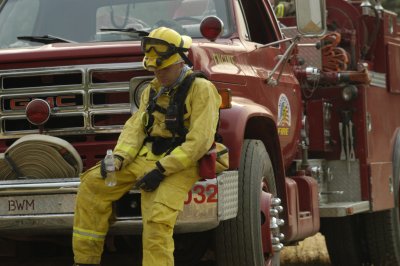
A tired Northshore firefighter takes a break Monday evening. Photo by Elizabeth Larson.
Fire kicks into high gear
The fire stayed fairly calm until about noon, said Kemper.
Then the winds returned, with Robbins reporting gusts of up to 18 miles per hour from the northwest.
“Once the winds came up it just took off,” said Kemper.
Efforts to cut firebreaks with bulldozers to contain the fire were frustrated as the fire simply went over them.

A bulldozer works on a fire break Monday evening. Photo by Elizabeth Larson.
“It jumped a bunch of lines all day,” said Keith Leffler, a firefighter specialist with Northshore Fire who also works as a Cal Fire bulldozer operator.
Leffler did dozer work around some of the houses to get rid of brush and debris that might burn. Other firefighters stationed at homes in the subdivision also did prep and cleanup work to help protect the residences.
In response to the fire's flare up, fire officials brought in aircraft, including a DC-10 air tanker which made several fire retardant drops, said Robbins.
A mix of Cal Fire and hired aircraft – including Chinook and Sikorsky helicopters – pounded the fire with water and retardant throughout the afternoon and into the evening in the Red Rocks region east of Benmore Canyon and west of the Double Eagle.
“We're just hoping it's going to hold it,” said Robbins.
About 5:30 p.m., as the winds picked up, dark black smoke began curling up over the ridges, with the fire experiencing another flare up. The aircraft continued drops on the fire, which seemed to knock back its strength.
However, smoke created a serious visibility problem for aircraft, which included tactical units and spotters, several of them flying over the fire at once. Shortly before 7 p.m., Cal Fire began to call in the aircraft due to the low visibility, which created a dangerous situation for pilots.
Fighting fire with fire
Along Meriann Drive in the Double Eagle Ranch, a horse pasture had been bulldozed to create a safety zone where firefighters can retreat if the fire gets worse, said Robbins.
He met with Northshore Battalion Chief Pat Brown and an engine of weary firefighters just down the road from the safety zone Monday evening, where they discussed strategy moving forward.
Brown said he intended to stay on scene overnight to do a burning operation, in which he planned to set a fire and send it in a northerly direction in an attempt to try to stop the bigger fire.
He said he needed the Walker Fire to calm down overnight, and have a southerly breeze, in order to carry out the plan.
“We will save the houses,” said Brown.
Cal Fire also reported it planned to do a burn from the remote Four Corners area – where four roads, including Walker Ridge and Bartlett Springs road, meet – and have it burn toward Bear Valley Road in one direction and Bartlett Springs in the other, which should run parallel to Walker Ridge, said Robbins.
Emergency resources at hand
Many local emergency resources were on hand to assist firefighters and area residents.
Lake County Sheriff's Sgt. Gary Basor was at the command center in his capacity as the county's Office of Emergency Services coordinator.

From left, Sgt. Gary Basor, a telecommunications technician and Northshore Fire Chief Jim Robbins stand outside the mobile operations unit Monday evening. Photo by Elizabeth Larson.
On Sunday night Robbins put in a call for the mobile operations unit, a large trailer purchased with Homeland Security funds, featuring radios, laptops, a meeting room and other amenities for command leadership. Basor said this is the trailer's maiden voyage on a serious incident.
A Red Cross emergency shelter was set up at the Clearlake Oaks Fire Station under the direction of Pam Plank, the county's Red Cross disaster coordinator.
More than two dozen Double Eagle Ranch residents – plus some livestock and pets – were evacuated Sunday, as Lake County News has reported.
Campers at Indian Valley Reservoir also had been urged to leave, said Robbins.
As of Monday evening, the shelter had not been needed for any of the Double Eagle evacuees, so Plank and her cadre of volunteers – who had stayed at the shelter throughout the night to watch for anyone who needed help – were planning on closing the shelter.
Lake County Animal Care and Control has also been working to make sure animals were rescued from area homes.
On Monday they found a dog and a bird at a home in the Double Eagle and took them to safety, said staffer Sara Schramm.
Schramm said that no more livestock has been evacuated since Sunday, when four horses and about a dozen goats were removed to safety.
She and other Animal Care and Control staff got back to the shelter in Lakeport close to 11:30 p.m. Sunday after being on call most of the evening, she said.
There were concerns, however, that Double Eagle residents were trying to return to their homes as the fire's approach continued.
Robbins said they couldn't take the chance right now of letting residents back in.
Barricades and a California Highway Patrol cruiser were stationed at the entrance late Monday in an effort to discourage reentry into the subdivision.
Basor said it was for the residents' own safety that they had been asked to leave. If the winds were to shift the fire could move through the subdivision quickly, he said.
The county Department of Public Works reported Monday afternoon that it had closed Walker Ridge Road to all traffic with the exception of emergency personnel due to the fire.
Bartlett Springs Road is “enter at your own risk,” with no passage through to Indian Valley Reservoir, Public Works reported. Robbins said it's best of the public stays away from those areas for now.
In addition, he said there were still concerns that the fire could still burn down to Highway 20, forcing a closure.
The incident command post is expected to be moved to the Konocti Conservation Camp along Highway 29 on Tuesday afternoon, said Kemper.
That location will provide a larger facility for staging more firefighters – as many as a few thousand – and equipment should the fire grow larger, said Robbins.
Officials have stated that they believe the fire was caused by a lightning strike. Robbins said his units found the origin of the fire in Benmore Canyon on Sunday. Cal Fire investigators were reportedly investigating the scene Monday in order to make an official determination.
Area residents who have fire-related stories and experiences they wish to share are welcome to e-mail Elizabeth Larson at This email address is being protected from spambots. You need JavaScript enabled to view it..
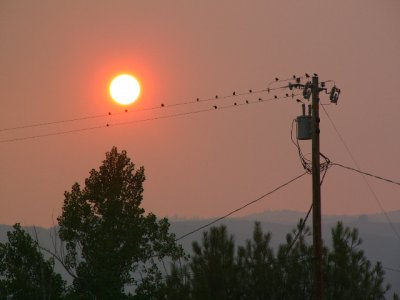
Spring Valley resident Vincent Stornaiuolo captured the bright orange sunset, caused by the fire's haze, from Spring Valley Monday evening. That area still could face evacuations if the fire shifts directions, officials reported.
{mos_sb_discuss:2}









